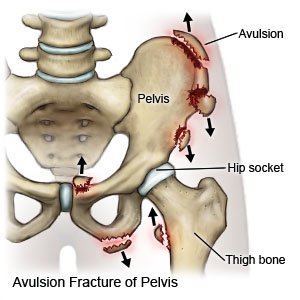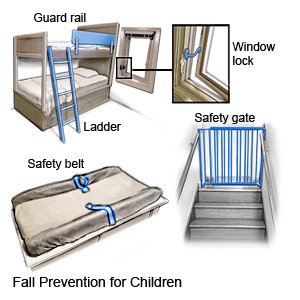Pelvic Avulsion Fractures in Children
Medically reviewed by Drugs.com. Last updated on Aug 4, 2025.
AMBULATORY CARE:
A pelvic avulsion fracture
occurs when a part of a hip bone breaks and tears away. This happens when a muscle or tendon connected to the hip bone suddenly tightens so hard that it pulls off part of the bone. Teenagers are more likely to have this injury than younger children.
 |
Common signs and symptoms:
- Sudden pain or a pop in the hip or groin during an activity
- Pain that is worse when the affected area is touched
- Swelling and trouble moving the hip and leg, or trouble sitting or walking
Seek care immediately if:
- Your child has increased swelling, pain, or redness in his or her hip.
- Your child has trouble moving his or her leg or foot.
- Your child's leg feels numb.
Call your child's doctor or orthopedist if:
- Your child has a fever.
- Your child has new symptoms.
- You have questions or concerns about your child's condition or care.
Treatment
may include any of the following:
- Prescription pain medicine may be given. Ask your child's healthcare provider how to give this medicine safely. Some prescription pain medicines contain acetaminophen. Do not give your child other medicines that contain acetaminophen without talking to a healthcare provider. Too much acetaminophen may cause liver damage. Prescription pain medicine may cause constipation. Ask your child's provider how to prevent or treat constipation.
- NSAIDs , such as ibuprofen, help decrease swelling, pain, and fever. This medicine is available with or without a doctor's order. NSAIDs can cause stomach bleeding or kidney problems in certain people. If your child takes blood thinner medicine, always ask if NSAIDs are safe for him or her. Always read the medicine label and follow directions. Do not give these medicines to children younger than 6 months without direction from a healthcare provider.
- Acetaminophen decreases pain and fever. It is available without a doctor's order. Ask how much to give your child and how often to give it. Follow directions. Read the labels of all other medicines your child uses to see if they also contain acetaminophen, or ask your child's doctor or pharmacist. Acetaminophen can cause liver damage if not taken correctly.
- Bed rest will help protect your child's hip while the fracture heals.
- Apply ice on your child's hip for 15 to 20 minutes every hour or as directed. Use an ice pack, or put crushed ice in a plastic bag. Cover it with a towel before you apply it. Ice helps prevent tissue damage and decreases swelling and pain.
- Crutches or a walker may be needed to keep weight off the area until it heals.
- Surgery may be needed for a fracture that is severe or does not heal with other treatments. Pins, screws, or plates may be used to hold the pieces in the correct positions.
Activity:
- Your child may need more rest than he or she realizes while healing. Quiet play will keep your child safely busy so he or she does not become restless and risk injury. Have your child read or draw quietly. Follow instructions for how much rest your child should get while he or she heals.
- Ask your child's healthcare provider when your child can be physically active again. Together you can plan the best exercise program for your child. It is best to start slowly and do more as he or she gets stronger. Do not let your child play sports, such as football or soccer, while his or her fracture is still healing.
- Make sure your child uses crutches or a walker correctly. To keep him or her or her from falling, remove loose rugs from the floor. It may be easier for your child to get out of a chair if he or she uses chairs with side arms and hard cushions. Your child may also want to use a shower chair to help prevent falls while he or she bathes.

Ice:
Apply ice on your child's hip for 15 to 20 minutes every hour or as directed. Use an ice pack, or put crushed ice in a plastic bag. Cover it with a towel before you place it on your child's fracture area. Ice helps prevent tissue damage and decreases swelling and pain.
Physical therapy:
A physical therapist may teach your child exercises to strengthen his or her hip and legs after the pain is gone.
Follow up with your child's doctor or orthopedist as directed:
Write down your questions so you remember to ask them during your visits.
© Copyright Merative 2025 Information is for End User's use only and may not be sold, redistributed or otherwise used for commercial purposes.
The above information is an educational aid only. It is not intended as medical advice for individual conditions or treatments. Talk to your doctor, nurse or pharmacist before following any medical regimen to see if it is safe and effective for you.
Learn more about Pelvic Avulsion Fractures
Care guides
Further information
Always consult your healthcare provider to ensure the information displayed on this page applies to your personal circumstances.
